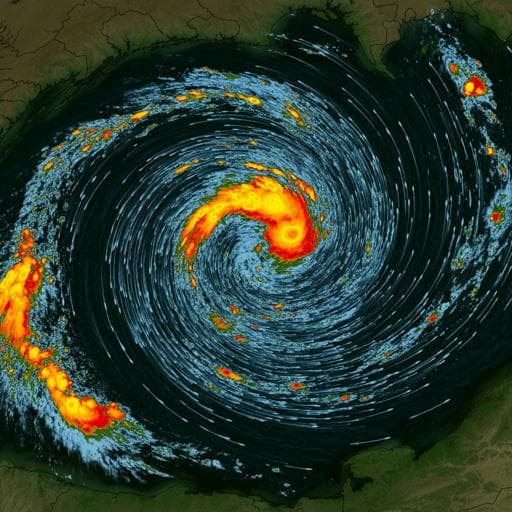
Earth Sciences
Soil moisture-constrained East Asian Monsoon meridional patterns over China from observations
W. Ullah, C. Zhu, et al.
Discover how soil moisture oscillations significantly influence East Asian Monsoon precipitation variability across China. This research, conducted by Waheed Ullah, Chenxia Zhu, Guojie Wang, Daniel Fiifi Tawia Hagan, Dan Lou, Jiangfeng Wei, Aisha Karim, Shijie Li, Buda Su, and Tong Jiang, reveals that changes in soil moisture can account for 40% of precipitation variance, providing crucial insights for improving weather forecasts.
~3 min • Beginner • English
Introduction
The study addresses how meridional soil moisture (SM) oscillations between northern and southern China modulate interannual variability of East Asian Monsoon (EAM) precipitation. Given the EAM’s socioeconomic impacts through floods, droughts, and heatwaves, and the complex interactions among land, ocean, atmosphere, and cryosphere, the authors hypothesize that SM—an internal forcing with memory from weeks to months—plays a quantifiable role in controlling the meridional positioning and intensity of the EAM rainband. The purpose is to quantify the variance in EAM precipitation attributable to SM, determine the strength and sign of SM–precipitation coupling across China’s river basins, and elucidate mechanisms linking SM anomalies to boundary layer processes, diabatic heating, large-scale circulation, and moisture transport. This has importance for improving interannual prediction skill of EAM precipitation, particularly under projected north–south wetting/drying contrasts and warming-enhanced extremes.
Literature Review
Prior work highlights multiple EAM drivers and characteristics: land–atmosphere feedbacks, SST and oceanic teleconnections (including ENSO phases), cryospheric influences (e.g., Tibetan Plateau snow), and atmospheric circulation regimes affecting onset, advance, and retreat. Studies show SM’s influence on precipitation via energy fluxes, diabatic heating, and divergent circulations; SM can trigger circulation patterns and Rossby wave trains, affecting remote climate and extremes. Over East Asia, SM has been linked to EAM precipitation sensitivity and land–atmosphere coupling, with spring SM affecting summer precipitation and atmospheric circulation. Inclusion of realistic SM improves monsoon onset simulation by representing land–sea thermal contrast. Observations and modeling suggest northern EAM rainfall sensitivity to local evapotranspiration and strong SM–temperature coupling, with SM potentially surpassing oceanic forcing at certain timescales. However, gaps remain: limited quantification of SM’s variance contribution to EAM, a lack of observationally constrained analyses, and uncertainties due to reanalysis dependence and model structural biases. This study aims to quantify the variance fraction of EAM precipitation forced by SM meridional oscillations and clarify mechanisms.
Methodology
Data and period: CMA gridded precipitation (0.5°) based on 2474 stations; ESA-ECV satellite soil moisture (volumetric, resampled 50 km, JJA, 1981–2018, with 3D gap-filling; rescaled to ERA5 SM via CDF matching); ERA5 reanalysis (surface and atmospheric variables; 31 km, 137 levels). Analyses conducted primarily for 1981–2018; regional model experiments for 2000–2018.
Statistical analyses: 1) Empirical Orthogonal Function (EOF) analysis of JJA precipitation (1981–2018) to identify leading meridional dipole mode (PC1). 2) Pixel-wise Pearson correlations between PC1 and JJA SM to map SM–precipitation coupling. 3) Coupled Manifold Technique (CMT) to decompose precipitation into portions statistically forced by SM and free from SM, estimating variance ratios forced by SM. CMT uses EOF-reduced, CCA-scaled principal components and Procrustes minimization to derive forcing operators; significance of fully coupled manifolds tested with 1000-member Monte Carlo at 99% confidence. 4) Definition of a soil moisture index (SMI) as area-averaged SM north (35–44°N, 99–120°E) minus south (22–31°N, 99–120°E) to represent meridional SM dipole; correlation between SMI and forced-precipitation PC1 assessed. 5) Composite analysis of years with |standardized| values >1 for SM-forced PC1 and SMI: SMI_wet (1988, 1990, 1996, 2003, 2004, 2011) versus SMI_dry (1982, 1997, 1999, 2001, 2002, 2015, 2017). Composites examined for SM, precipitation, surface energy fluxes (SH, LH), boundary layer properties, diabatic heating, vertical motion, wind anomalies, and moisture transport. Significance assessed at 95% where noted.
Regional climate model experiments: ICTP RegCM4.7.0 coupled with BATS land surface scheme (three SM layers to 3 m). Emanuel convection over land and SUBEX for large-scale precipitation. Lateral boundary conditions and SST from ERA-Interim (6-hourly and weekly, respectively), identical across experiments to isolate SM effects. Two experiments for 2000–2018 (1998–1999 spinup): SM_ECV (daily first-timestep SM replaced with ESA-ECV SM anomalies) and SM_CLIM (daily first-timestep SM replaced with SM climatology). Vertical velocity, winds, SH, LH, precipitation diagnostics computed; composites formed for SMI_wet (2003, 2004, 2011) and SMI_dry (2001, 2002, 2015, 2017) to analyze meridional differences and circulation changes. Pattern statistics of SM_ECV vs observations/reanalysis documented via Taylor diagrams (Supplementary). Additional diagnostics include Helmholtz decomposition for divergent wind and vertically integrated moisture flux convergence (continuity-based formulations).
Key Findings
- Observational EOF of JJA precipitation reveals a meridional oscillation (north–south dipole) explaining 48% of total variance.
- PC1 of precipitation correlates significantly with JJA SM across the EAM domain, exhibiting a meridional dipole: negative correlations in northern China (e.g., northern Yangtze, Yellow, Haihe, NE China; coefficients < -0.60) and positive in southern China (southern Yangtze, Pearl River; > 0.65), indicating strong SM–precipitation linkage.
- CMT shows a significant fraction of EAM JJA precipitation is forced by SM at 99% confidence. Regional variance ratios forced by SM are high in: Huaihe/Haihe basins (~0.38), southern Yangtze (~0.37), and Tibetan Plateau (~0.32). The leading mode of SM-forced precipitation explains 63% of forced variance and exhibits an evident meridional dipole.
- The SMI (north minus south SM) is significantly negatively correlated with the PC1 of SM-forced precipitation (r = -0.62, 95% significance), implying positive SMI (wetter north, drier south) shifts the precipitation band northward; negative SMI shifts it southward.
- Composites: SMI_wet shows positive SM anomalies north of Yangtze (≈ +0.02 m³ m⁻³) and negative in the south (≈ -0.03 m³ m⁻³), with precipitation anomalies of about +40 mm in northern basins and -40 mm in southern China; SMI_dry reverses sign (north ≈ -0.02 m³ m⁻³; south ≈ +0.03 m³ m⁻³) and precipitation anomalies (north -45 mm; south +50 mm). SM anomalies are typically stronger over arid-to-transitional north and wet-to-humid south, while precipitation anomalies maximize in transitional and humid zones.
- Mechanism: Positive SM anomalies reduce SH and increase LH in affected regions, modifying boundary layer depth and vertical diabatic heating, which alters easterlies and midlatitude westerlies, moisture transport, and vertical motion, producing meridional precipitation oscillation.
- Model experiments (SM_ECV − SM_CLIM) during SMI_wet show decreased SH over northern China (~ -10 W m⁻²) and increased SH in the south (~ +12 W m⁻²); LH increases in the north (~ +12 W m⁻²) and decreases in the south. During SMI_dry, SH is weaker in the north and moderately negative in the south (≈ -6 W m⁻²), with LH moderately increased in the north and larger increases in the south.
- Precipitation differences (SM_ECV − SM_CLIM): SMI_wet yields higher precipitation in northern China (up to ~ +110 mm) and decreased in southern China (~ -80 mm); SMI_dry shows the opposite spatial shift.
- Circulation: In SMI_wet, intensified westerlies merge into a cyclonic circulation over the east coast; extratropical westerlies and midlatitude northwesterlies ascend over northern China (enhanced northern precipitation). Subtropical easterlies descend into southern China (suppressed southern precipitation). In SMI_dry, the cyclone shifts southeast; descending ridges suppress northern precipitation, while subtropical westerlies from the Bay of Bengal favor enhanced southern precipitation.
- Overall, SM forcing explains about 0.40 of the variance ratio in north and south China and can potentially improve interannual EAM forecast skill.
Discussion
The findings directly address the research question by quantifying the portion of interannual EAM precipitation variability attributable to meridional SM oscillations and by elucidating the land–atmosphere mechanisms. A positive SM anomaly in northern China weakens sensible heating and enhances latent heating, stabilizes boundary layer thermodynamics differently across regimes, and modifies diabatic heating profiles. These thermodynamic changes propagate to alter large-scale circulation (strength/positioning of Pacific easterlies and midlatitude westerlies) and moisture flux pathways, shifting the EAM rainband northward; opposite anomalies in southern China shift it southward. The significant forced variance fractions and consistent composite anomalies across observations and targeted model experiments confirm a robust SM control on EAM meridional precipitation patterns. This demonstrates that SM, with its intrinsic memory, is a valuable source of predictability for interannual EAM precipitation, complementing or, at times, surpassing oceanic precursors. These results are highly relevant for flood/drought risk management, water and energy cycle assessments, and adaptation planning under projected north–south wetting/drying trends and warming-enhanced extremes.
Conclusion
This study provides an observationally constrained quantification and mechanistic understanding of how meridional soil moisture anomalies force interannual East Asian Monsoon precipitation patterns across China. Using EOF, correlation mapping, and CMT, the authors show that SM explains a substantial fraction (up to ~0.4 regionally) of EAM precipitation variability, with a leading SM-forced mode capturing a meridional dipole. Composite diagnostics and controlled regional climate model experiments confirm that SM anomalies modulate surface energy fluxes, boundary layer and diabatic heating, circulation, and moisture transport, thereby shifting the monsoon rainband between northern and southern China. Practically, assimilating or constraining models with observed SM can improve interannual EAM prediction skill. Future work should jointly assess SM and oceanic forcings, reduce boundary layer and topography-related model biases, extend multi-source SM observations, and further explore moisture source–sink dynamics and remote teleconnections to enhance predictive capabilities.
Limitations
- Model-related uncertainties, including boundary layer and topographic biases, lead to regional precipitation pattern biases (e.g., Northeast China underestimation, Yangtze basin overestimation). - Dependence on reanalysis and satellite SM products with rescaling introduces data uncertainties; ESA-ECV SM provides surface-layer estimates requiring profiling assumptions for deeper layers. - The mechanistic attribution between SM and EAM interacts with concurrent oceanic forcings; this study controls SST in experiments but does not fully explore joint SM–SST variability and teleconnections. - Limited period for high-quality satellite SM (post-2000) constrains model experiment duration and robustness across decadal variability. - Statistical significance is robust (Monte Carlo), but causality remains inferred via targeted experiments rather than fully coupled data assimilation frameworks.
Related Publications
Explore these studies to deepen your understanding of the subject.







